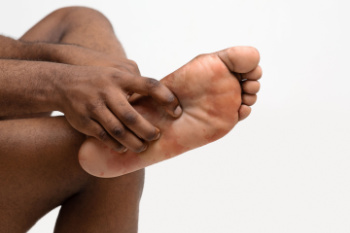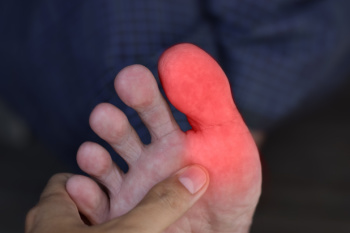Town Square Family Foot Care has permanently closed.
Dr. Scholz has accepted a position as a Podiatrist in the Department of Orthopedics and Rehabilitation at University of Iowa Health Care. If you’d like to schedule an appointment, call 319-356-2223.
If you would like to have your records sent to another provider, please send a record release form found on our website, 341foot.com, to our secure email contactus@341foot.net.
Blog
Items filtered by date: August 2024
Heel Pain Can Be Treated!
Exercising Flat Feet for Better Foot Health

Flat feet, or fallen arches, occur when the arches of the feet collapse, leading to potential discomfort and alignment issues. To alleviate symptoms and strengthen the feet, several exercises can be beneficial. Heel stretches involve gently pulling the heel and calf muscles to increase flexibility and reduce tension. Rolling a tennis ball under the foot helps massage the arch, improve circulation, and relieve pain. Arch lifts, performed by lifting the arch while keeping the toes and heel on the ground, strengthen the muscles supporting the arch. Calf raises, where you rise onto the toes and slowly lower back down, enhance calf strength and support the foot’s structure. Flat feet may cause pain and discomfort. If this applies to you, it is suggested that you are under the care of a podiatrist who can help you find the relief you are seeking.
Flatfoot is a condition many people suffer from. If you have flat feet, contact Jill Scholz, DPM from Town Square Family Foot Care. Our doctor will treat your foot and ankle needs.
What Are Flat Feet?
Flatfoot is a condition in which the arch of the foot is depressed and the sole of the foot is almost completely in contact with the ground. About 20-30% of the population generally has flat feet because their arches never formed during growth.
Conditions & Problems:
Having flat feet makes it difficult to run or walk because of the stress placed on the ankles.
Alignment – The general alignment of your legs can be disrupted, because the ankles move inward which can cause major discomfort.
Knees – If you have complications with your knees, flat feet can be a contributor to arthritis in that area.
Symptoms
- Pain around the heel or arch area
- Trouble standing on the tip toe
- Swelling around the inside of the ankle
- Flat look to one or both feet
- Having your shoes feel uneven when worn
Treatment
If you are experiencing pain and stress on the foot you may weaken the posterior tibial tendon, which runs around the inside of the ankle.
If you have any questions please feel free to contact our office located in Coralville, IA . We offer the newest diagnostic and treatment technologies for all your foot and ankle needs.
Treating Plantar Fasciitis

Plantar fasciitis is a prevalent foot condition caused by inflammation of the plantar fascia, which is a thick band of tissue running along the bottom of the foot, connecting the heel bone to the toes. It often results from overuse, wearing improper footwear, or high-impact activities. Symptoms can include sharp, stabbing heel pain, particularly noticeable with the first steps in the morning or after periods of inactivity. The pain may also increase after prolonged standing or intense physical activity. To ease the pain, stretching exercises targeting the Achilles tendon and plantar fascia can be beneficial. Using mild pain relievers and wearing supportive shoes or orthotic inserts can also help. If you have persistent pain from plantar fasciitis, it is suggested that you consult a podiatrist to see if corticosteroid injections might help to reduce inflammation and promote healing, in addition to other viable treatment methods.
Plantar fasciitis is a common foot condition that is often caused by a strain injury. If you are experiencing heel pain or symptoms of plantar fasciitis, contact Jill Scholz, DPM from Town Square Family Foot Care. Our doctor can provide the care you need to keep you pain-free and on your feet.
What Is Plantar Fasciitis?
Plantar fasciitis is one of the most common causes of heel pain. The plantar fascia is a ligament that connects your heel to the front of your foot. When this ligament becomes inflamed, plantar fasciitis is the result. If you have plantar fasciitis you will have a stabbing pain that usually occurs with your first steps in the morning. As the day progresses and you walk around more, this pain will start to disappear, but it will return after long periods of standing or sitting.
What Causes Plantar Fasciitis?
- Excessive running
- Having high arches in your feet
- Other foot issues such as flat feet
- Pregnancy (due to the sudden weight gain)
- Being on your feet very often
There are some risk factors that may make you more likely to develop plantar fasciitis compared to others. The condition most commonly affects adults between the ages of 40 and 60. It also tends to affect people who are obese because the extra pounds result in extra stress being placed on the plantar fascia.
Prevention
- Take good care of your feet – Wear shoes that have good arch support and heel cushioning.
- Maintain a healthy weight
- If you are a runner, alternate running with other sports that won’t cause heel pain
There are a variety of treatment options available for plantar fasciitis along with the pain that accompanies it. Additionally, physical therapy is a very important component in the treatment process. It is important that you meet with your podiatrist to determine which treatment option is best for you.
If you have any questions, please feel free to contact our office located in Coralville, IA . We offer the newest diagnostic and treatment technologies for all your foot care needs.
Common Causes of Big Toe Joint Pain

Pain in the big toe joint can stem from various conditions, with arthritis, bunions, and extensor tendonitis being common culprits. Arthritis in the big toe joint often leads to inflammation and stiffness, resulting in discomfort and limited movement. A bunion, characterized by a bony protrusion at the base of the big toe, can cause significant pain due to misalignment and increased pressure on the joint. Extensor tendonitis occurs when the tendons responsible for lifting the toe become inflamed, leading to pain and difficulty in movement. Each condition can contribute to discomfort and mobility issues, making early diagnosis and appropriate treatment essential for effective management and relief. If you have pain in your big toe, it is suggested that you consult a podiatrist who can accurately diagnose the cause and offer you appropriate treatment solutions.
Toe pain can disrupt your daily activities. If you have any concerns, contact Jill Scholz, DPM of Town Square Family Foot Care. Our doctor can provide the care you need to keep you pain-free and on your feet.
What Causes Toe Pain?
Most severe toe pain is caused due to a sports injury, trauma from dropping something heavy on the toe, or bumping into something rigid. Other problems can develop over time for various reasons.
Toe pain can be caused by one or more ailments. The most common include:
- Trauma
- Sports injury
- Wearing shoes that are too tight
- Arthritis
- Gout
- Corns and calluses
- Hammertoe
- Bunions
- Blisters
- Ingrown toenails
- Sprains
- Fractures (broken bones)
- Dislocations
When to See a Podiatrist
- Severe pain
- Persistent pain that lasts more than a week
- Signs of infection
- Continued swelling
- Pain that prevents walking
Diagnosis
In many cases the cause of toe pain is obvious, but in others, a podiatrist may want to use more advanced methods to determine the problem. These can range from simple visual inspections and sensation tests to X-rays and MRI scans. Prior medical history, family medical history, and any recent physical traumatic events will all be taken into consideration for a proper diagnosis.
Treatment
Treatments for toe pain and injuries vary and may include shoe inserts, padding, taping, medicines, injections, and in some cases, surgery. If you believe that you have broken a toe, please see a podiatrist as soon as possible.
If you have any questions please feel free to contact our office located in Coralville, IA . We offer the newest diagnostic tools and technology to treat your foot and ankle needs.
Complications of a Broken Toe

A broken toe might seem like a minor injury, but it can lead to significant complications if not properly treated. Untreated fractures can result in persistent pain, deformities, reduced mobility, and long-term difficulties in walking. Fractures that affect the big toe can lead to deformities and a restricted range of motion. Toe fractures that involve joint cartilage can cause traumatic osteoarthritis and further joint deformities. Surgery, although sometimes necessary, carries risks such as nerve damage and infection. Seeing a podiatrist promptly after a toe injury ensures that the fracture is correctly diagnosed and appropriately managed. A podiatrist can provide such treatment as casting or buddy taping, to keep the injured toe straight and immobilized while healing. Treatment for a broken toe typically involves a cast or tape to keep the toe straight and promote healing. Depending on the toe and the severity of the injury, it may take up to eight weeks for the fracture to heal. If you have broken a toe, it is suggested that you schedule an appointment with a podiatrist for an exam, diagnosis, and treatment options.
A broken toe can be very painful and lead to complications if not properly fixed. If you have any concerns about your feet, contact Jill Scholz, DPM from Town Square Family Foot Care. Our doctor will treat your foot and ankle needs.
What to Know About a Broken Toe
Although most people try to avoid foot trauma such as banging, stubbing, or dropping heavy objects on their feet, the unfortunate fact is that it is a common occurrence. Given the fact that toes are positioned in front of the feet, they typically sustain the brunt of such trauma. When trauma occurs to a toe, the result can be a painful break (fracture).
Symptoms of a Broken Toe
- Throbbing pain
- Swelling
- Bruising on the skin and toenail
- The inability to move the toe
- Toe appears crooked or disfigured
- Tingling or numbness in the toe
Generally, it is best to stay off of the injured toe with the affected foot elevated.
Severe toe fractures may be treated with a splint, cast, and in some cases, minor surgery. Due to its position and the pressure it endures with daily activity, future complications can occur if the big toe is not properly treated.
If you have any questions please feel free to contact our office located in Coralville, IA . We offer the newest diagnostic and treatment technologies for all your foot and ankle needs.
Blog Archives
- February 2025
- January 2025
- December 2024
- November 2024
- October 2024
- September 2024
- August 2024
- July 2024
- June 2024
- May 2024
- April 2024
- March 2024
- February 2024
- January 2024
- December 2023
- November 2023
- October 2023
- September 2023
- August 2023
- July 2023
- June 2023
- May 2023
- April 2023
- March 2023
- February 2023
- January 2023
- December 2022
